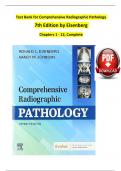Test Bank for Comprehensive Radiographic Pathology
7th Edition by Eisenberg
Chapters 1 - 12, Complete
,Table Of Contents
1. Introduction to Pathology
2. Specialized Imaging Techniques
3. Respiratory System
4. Skeletal System
5. Gastrointestinal System
6. Urinary System
7. Cardiovascular System
8. Nervous System Disease
9. Hematopoietic System
10. Endocrine System
11. Reproductive System
12. Miscellaneous Diseases
, Chapter 1: Introduction to Pathology
Test Bank
MULTIPLE CHOICE
1. A disease process caused by physicians or their treatment is this type of process.
a. Idiopathic
b. Iatrogenic
c. Neoplasia
d. Community acquired
ANSWER: B
The disease process caused by physicians and their treatment is iatrogenic.
REF: p. 3
2. Basic reactions of the body to some form of injury is a:
a. Disease process
b. Pathology
c. Study of diseases
d. Idiopathic process
ANSWER: A
A disease is the pattern of the body’s response to some form of injury.
REF: p. 1
,3. What term is used to denote a disease in which the underlying cause is unknown?
a. Idiopathic
b. Antietiologic
c. Iatrogenic
d. Nosocomial
ANSWER: A
Idiopathic diseases are those with an unknown, or as of yet unidentified, cause.
REF: p. 3
4. Alterations of cell growth, specifically an abnormal proliferation of cells is called:
a. Hyperplasia
b. Dysplasia
c. Neoplasia
d. Aplasia
ANSWER: C
Alterations in cell growth lead to the development of neoplasms (tumors).
REF: p. 7
5. The initial response of body tissues to local injury is:
a. Infection
b. Ischemia
c. Edema
d. Inflammation
ANSWER: D
Inflammation is the initial response of body tissues to local injury.
, REF: p. 3
6. Heat and redness associated with inflammation is produced by:
a. Hyperemia
b. Scar tissue
c. Hyperplasia
d. Infarction
ANSWER: A
This hyperemia produces the heat and redness associated with inflammation.
REF: p. 3
7. In an injury, the destroyed tissue is replaced with:
a. Granulomatous inflammation
b. Granulation tissue
c. Phagocytes
d. Pyogens
ANSWER: B
A fibrous scar replaces the area of destroyed tissue with granulation tissue. Granulation tissue refers
to a combination of young, developing capillaries and actively proliferating fibroblasts, which
produce connective tissue fibers (collagen) that replace the dead tissue.
REF: p. 4
8. Of the five clinical signs of acute inflammation, the medical term for swelling is:
a. Edema
b. Tumor
c. Calor
, d. Dolor
ANSWER: B
The five clinical signs of acute inflammation are rubor (redness), calor (heat), tumor (swelling), dolor
(pain), and loss of function.
REF: p. 4
9. Some bacterial organisms that produce these substances that cause damage to the tissue and incite
the inflammatory process are known as:
a. Toxoids
b. Pyogens
c. Toxins
d. Abscesses
ANSWER: C
Some bacterial organisms (such as staphylococci and streptococci) produce toxins that damage the
tissues and incite an inflammatory response.
REF: p. 4
10. Chronic inflammation in a localized area, which often has a centralized necrosis is called:
a. An exudates
b. A granuloma
c. An abscess
d. Hyperplasia
ANSWER: B
A granuloma is a localized area of chronic inflammation, often with central necrosis.
REF: p. 4
,11. In acute inflammation, the localized heat and redness are a result of the:
a. Migration of circulating white blood cells
b. Increased blood flow and vascular permeability
c. Regeneration of normal parenchymal cells
d. Enzymatic digestion of dead cells
ANSWER: B
The localized heat and redness result from increased blood flow in the microcirculation at the site of
injury.
REF: p. 4
12. In pyogenic infections, the body responds by producing a thick, yellow fluid called:
a. Bacteria
b. Pus
c. Edema
d. A scar
ANSWER: B
The presence of pyogenic bacteria leads to the production of a thick, yellow fluid called pus, which
contains dead white blood cells, inflammatory exudates, and bacteria.
REF: p. 4
13. All pyogens have the ability to enter the blood circulation causing:
a. Bacteremia
b. Phagocytosis
c. Septicemia
d. Keloid tissue
, ANSWER: A
All pyogens, wherever they become implanted, have the ability to invade blood vessels to produce
bacteremia, with the potential involvement of other organs and tissues in the body.
REF: p. 4
14. Connective tissue fibers replacing dead tissue, then contracting in the abdomen are known as:
a. Keloids
b. Suppurative inflammation
c. Fibrous adhesions
d. Hyperemia
ANSWER: C
Eventually the strong connective tissue contracts to produce a fibrous scar. In the abdomen, such
fibrous adhesions can narrow loops of intestine and result in an obstruction.
REF: p. 4
15. An accumulation of abnormal amounts of fluid in the intercellular tissue throughout the body is
called:
a. Bacteremia
b. Elephantiasis
c. Filariasis
d. Anasarca
ANSWER: D
Generalized edema occurs with pronounced swelling of subcutaneous tissues throughout the body
(anasarca).
REF: p. 4
16. Localized is produced in an inflammatory reaction as a result of a fluid accumulation.
, a. Filariasis
b. Edema
c. Elephantiasis
d. Fibrous adhesions
ANSWER: B
Edema is the accumulation of abnormal amounts of fluid in the intercellular tissue spaces or body
cavities. Localized edema results from an inflammatory reaction.
REF: p. 4
17. An inflammation associated with pus formation is:
a. Bacteremia
b. Phagocytosis
c. Suppurative
d. Hyperemia
ANSWER: C
Suppurative inflammation is associated with pus formation.
REF: p. 4
18. The protein-rich fluid associated with swelling in an inflammatory process is:
a. Exudate
b. Transudate
c. Pus
d. Permeable
ANSWER: A




